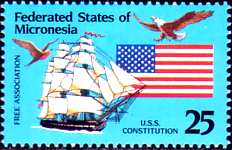
| Maritime Topics On Stamps :
Old Ironsides,
U.S.S. 'Constitution'!
|
|
The U.S. frigate 'Constitution' is the world’s oldest warship still afloat.
Commissioned in 1797, she is thus over 200 years old. Despite
extensive overhauls and repairs over the years, she still retains her
original keel and therefore is considered an 'original ship'.
She lies today as museum ship in Boston. In 1812, during combat with HMS
'Guerriere', American sailors observed that the British frigate’s balls could not
penetrate ‘Constitution’s hull, earning her the everlasting nickname, 'Old
Ironsides'.
|
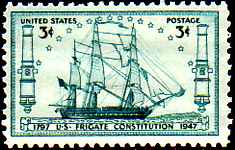
|
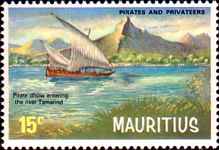
|
Throughout the 18th century, the Mediterranean and the Straits of Gibraltar
were feared hunting grounds of the Barbary pirates from Morocco, Tunis,
Tripoli, and Algeria.
(See a corsair’s sailing vessel on the left.) France and England paid hefty
tributes
to the Pashas of the Berbercoast and were left in peace. Without a navy to
protect them, American ships became easy prey to these pirates. In 1793 eleven
American ships were captured and faced outrageous demands for ransom .
Something had to be done. The U.S. ministers to France and England, Thomas Jefferson
and John Adams, said it would be cheaper to build a navy to protect American
shipping than to pay tribute. Finally, in March of 1794 Congress passed a bill
leading to the building of six frigates.
|
|
These American frigates were to be superior in firepower to any other
frigates and fast enough to outrun any British warship, while outmaneuvering any
vessel of the same size.
Here some data to the 'Constitution':
Construction period from 1794 to 1797 in Boston. L 204 ft, B 43.5 ft, D
22.5ft. Foremast 198 ft, mainmast 220 ft, mizzenmast 172.5 ft, displacement 2,200
tons, Sail area 42,710 square feet with Leesails, speed max. 14 kn, able to to be
close hauled 6 points to the wind.
Armament: 32 24-pounders, 20 32-pounders and two 24-pounders in the bows.
The hull, an oak skin from 1.3 to 1.7 ft thick, was fitted with copper
plates. Crew 450 men.
|
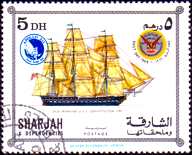
| |
Simultaneously, the 'United States' was built in Philadelphia, the
'Constellation' in Baltimore, and commissioned in 1797 and 1798, respectively.
Construction of the other three frigates had been stopped in the meantime,
because in September 1795 the Dey of Algeria had agreed to a peace agreement.
Yet, problems with France eventually led to the completion in 1799 of the '
Chesapeake ' in Gosport and the ' Congress ' in New Hampshire.
The following year saw the launching of the ' President ' in New York.
|
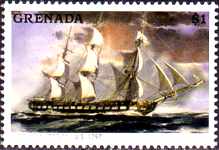
|
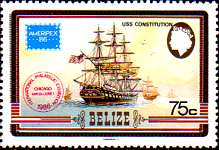
| |
When the British saw these frigates, they reached the conclusion that
the Americans had created ugly hybrids, half frigate, half ship-of-the-line,
and combining few of the advantages of either type. They would soon find out
differently.
The ‘Constitution' was dispatched against the French in the Caribbean. She
made two prizes which however had to be given up, being British ships previously
taken by the French.
In 1801 the Pasha of Tripoli intended to extort more tribute capturing
American ships and locking up the crews. In 1803 the Americans sent a fleet
with the 'Constitution' into the Mediterranean. Tripoli was bombarded. In June
of 1805
a peace treaty was signed on board the 'Constitution'.
Thereafter she became the flagship of the U.S. North Atlantic fleet.
|
|
In the year 1806 some 800 men-of-war with 150,000 people were flying the
ensign of the Royal Navy. Life was hard, governed by the whip, and sailors were
prone to desert whenever an opportunity arose.
For replacements, the Royal Navy sent press gangs into coastal towns
kidnapping any able-bodied men they could find, and by forcibly removing sailors from
foreign flag merchant ships. (See stamp.)
American vessels especially became frequent victims of this British
operation, members of their crews declared to be subjects of the Crown and pressed into
the Royal Navy.
By 1811 Washington had registered some 6,000 cases of abducted American
sailors; the British admitted to a number of 3,300.
|
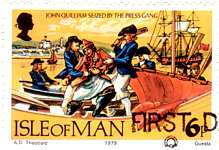
|
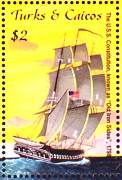
|
A number of incidents on the high seas led to the breaking point and in 1812
the United States declared war on Great Britain. At this time the American
fleet consisisted of 54
vessels with 442 guns. The Royal Navy possessed some 900 ships with 27,800
guns, and of these, approximately 100 were deployed in the western Atlantic.
With those numbers, the British did not believe their American foes a fighting
force to be taken seriously.
Such were the circumstances in July of 1812 when ‘Constitution' met a British
squadron of one ship-of-the-line, three frigates, one brig and a schooner.
For the Yankees, a fight would have been suicide, and added to the misfortune
was a total calm that paralyzed all seven ships.
|
|
The Americans sprayed water on the sails to catch the slightest breeze. So
did the British. The Americans placed their boats into the sea and pulled the
frigate forwards. The British did the same with their vessels. The Americans set
ankers ahead on long ropes and warped the ship forwards. The British repeated
that maneuver too, they really wanted this prize. This continued for two days
until utter exhaustion on both sides. Then, a slight breeze, followed by a
thunderstorm, provided 'Constitution' with an 11 knots speed. She flew away,
the British could not follow.
|
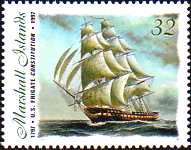
|
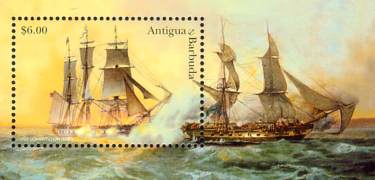
|
In August 1812 'Constitution' encountered the British frigate 'Guerriere’.
Being in a more favorable position, ‘Guerriere' started firing immediately.
While her balls bounced off the ‘Constitution‘s sides, Capt. Hull maneuvered his
ship close in without delivering a shot. At a distance of just 80 ft Hull
spoke the historical words: 'Now, boys, pour it into
them'. ‘Constitution’s heavier guns knocked down ‘Guerriere’s mizzenmast
and, with two devastating broadsides, raked her from stem to stern. Only 35
minutes later, 'Guerriere' struck her colors. The ship was so badly damaged that
she could not be taken as a prize. The crew was taken off and ‘Guerriere '
was blown up.
As they observed that British balls were bouncing off the 'Constitution's
hull, the American sailors shouted 'Her sides are made of iron!’ giving rise to
the frigate’s everlasting nickname 'Old Ironsides'.
|
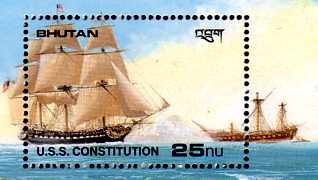
|
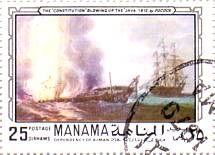
| |
In December 1812 ‘Constitution' met the British frigate 'Java' off the
Brazilian coast. The ships fought for three-and-a-half hours, constantly maneuvering
against each other seeking a better broadside position. Their guns were
firing away all the time. When ‘Constitution’s rudder was shot away, tackles
were rigged up immediately and
the ship was steered with them. At one time the ships crashed together and
both
sides tried to board each other, but then they drifted apart again. Then the
‘Java’s mizzenmast crashed down and the ship began to burn. ‘Java’ stroke
her colors. The ship was so damaged she had to be abandoned. But
‘Constitution’ also had suffered extensive damage requiring repairs.
|
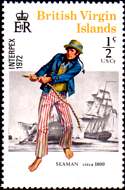
|
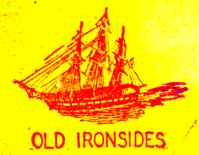
|
1813 saw ‘Constitution' capturing several British merchant ships. Then came
almost a year in Boston harbor while blockaded by the British fleet. It was
winter when she succeeded in breaching the blockade.
‘Constitution’s last important battle was fought in February of 1815 when
she met the two British frigates 'Cyane' and 'Levant'.
During this night action Capt. Stewart demonstrated extraordinary feats of
seamanship, maneuvering ‘Constitution’ always into a position where he faced
just one opponent at a time, the other one staying covered by the first.
After three hours of combat, both ‘Cyane' and 'Levant' were so heavily
damaged that they struck the colors. Both were taken as prizes -- but then had to be
returned to Britain after the war.
At the time of this engagement, the peace treaty between Great Britain and
the United States had already been signed, on Dec. 24,1814. But it took quite a
while for the news to reach the ships still fighting in the Atlantic.
Above left depicts an American sailor around 1800; on the right we see a
cachet from the year 1933.
|
USS 'Constitution's later history:
- 1815 -- Laid-up and reconditioned over a period of six years.
- 1821 -- Flagship of the Mediterranean squadron.
- 1828 (1830) -- Returned to Boston, examined, declared unseaworthy, and
offered for sale to be scrapped. A Boston newspaper publishes a poem by Oliver
Holmes titled
'Old Ironsides' which is repeated in papers across the nation.
Outpouring of public protest causes Congress to grant funds for a thorough refit.
|
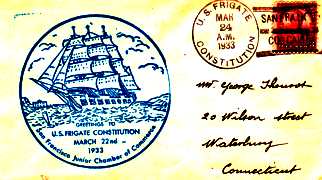
|
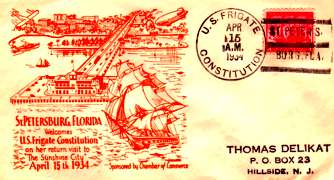
|
- 1835 -- 'Constitution' sails again, taking the American Ambassador to France.
Thereafter continues on cruises across the seas showing the American flag.
- 1844 to 1845 -- Voyage around the world. Saves a Western missionary from
execution on Borneo.
- 1846 -- Escort ship in the war with Mexico.
- 1848 -- In Egypt.
- 1849 -- Visited by Pope Pius IX.
- 1853-55 -- Anti-slavery patrols off the West Coast of Africa. Seizes a slave
schooner.
|
- 1860 -- Training ship for sea cadets.
- 1882-97 -- Accommodation ship at Portsmouth Navy Yard.
- 1897 -- Towed to Boston for celebrations honoring her Launching Centennial.
- 1905 -- Congress grants further 100,000 dollars for long overdue restauration.
'Constitution' becomes designated ‘National Monument'.
- 1927 -- Another large restoration happened.
- 1931 -- 'Constitution' officially rejoins the U. S. Navy. Towed along a
coast-to-coast route calling on 90 American ports in 21 states. 4.6 million
visitors stroll about her decks.
|
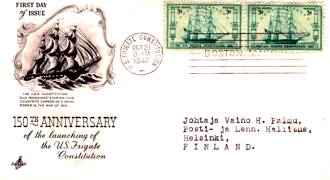
|
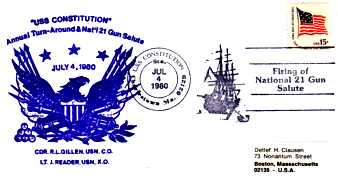
|
- 1975 -- Yet another restoration at a cost of 4.4 million dollars.
- 1997 -- For her Bicentennial , sails are set again on 'Constitution' and
she sails across Massachusetts Bay.
Thereafter, afloat in Boston harbor, permanently open to the public.
Once a year, she gets turned around at her berth to give both hull sides
equal exposure to the elements. (See letter at left.)
- 2003 -- 'Constitution' still well maintained and afloat in Boston harbor.
Public access regrettably curtailed due to terrorist threats to U.S. National Monuments.
|
|